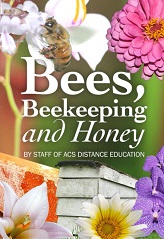Not All Bees Sting!
 Stingless bees have stings, however they are greatly reduced and therefore not capable of stinging.
Stingless bees have stings, however they are greatly reduced and therefore not capable of stinging.
Stingless bees store honey in a cluster of what looks more like a sheet of coloured bubble wrap than a traditional honeycomb. These bubble-like storage containers are called pots; and the honey from stingless bees is commonly called ‘pot honey’.
Stingless bees produce less honey than commercial honey bees; but they can be still worth while. Their honey can taste a little different too, and that may in some situations make it more desirable.
They have also been shown to be effective pollinators for a range of food crops.
Australian Stingless Bees
There are eleven species of Australian stingless bees. With a length of about 4 mm, these are a lot smaller than the commercial honeybee. Some species of Australian stingless bees are black with white fur on their sides and faces. Others are black with small yellow markings on their backs.
Australian stingless bees build nests inside hollow trees. As tropical species, they can be found in warm areas of Australia, such as Queensland, northern areas of Western Australia and the Northern Territory, and north-eastern areas of New South Wales.
Australian stingless bees only produce less than one litre of honey per year. This honey (known as Sugarbag) has a delicious and tangy taste. Stingless bees are also useful as pollinators for certain crops, such as macadamias, mangoes and watermelons, and for crops grown inside greenhouses.
Stingless bees can be purchased in Australia for honey production, including Austrophlebia species, Tetragonula hockingsi and Tetragonula carbonaria. In appropriate regions of Australia, you can keep Australian stingless bees in your backyard, in a natural log or hive box. The log or box should be placed at a site that receives morning sun and is sheltered from cold winds and extreme afternoon heat. The bees require flowers within approximately 100 metres of the nest for pollen and nectar collection. A nearby supply of water is also recommended. Ensure that your bees don’t come in contact with insecticides, as these can kill them. Phorid flies, syrphid flies and South African small hive beetles may attack damaged or weak hives.
African Stingless Bees
The genus Meliponula comprises relatively well known stingless bees in tropical and subtropical Africa. They are important as crop pollinators and are also kept for honey (known as Meliponiculture, rather than Apiculture which would strictly refer to keeping bees from the genus Apis). There are five other genera of stingless bees in Africa, but they have not been significant in the way that Meliponula has been.
Learn more about bees -read our bee book - see www.acsbookshop.com